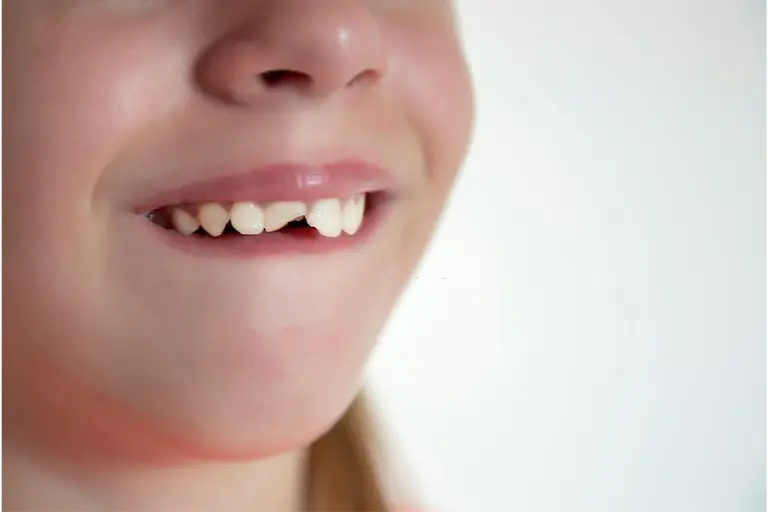It is common for children to experience a dental injury at some point in their life. As toddlers when they have just learned to walk or later when children grow up and engage in sports, your child may chip or break their tooth. If your child chipped a tooth, don’t worry and remember to visit a pediatric dentist to have it examined. Here is what to know about dental chipping or breaks in children, what you should do if it happens, and what treatment options are available.
A chipped tooth is normal in children
With their playful nature and high energy, kids are always running, falling, stumbling, and they may even be biting down hard on something. Therefore, it is no surprise if they have an impact on their teeth.
It is not always a worst-case scenario. Kids can have just a simple fracture where part of their tooth is chipped. But in less common cases, they may also have their permanent tooth completely knocked out of its socket. This is called a permanent tooth avulsion, which is the most severe type of dental trauma and requires immediate treatment.
It is wise that parents call the dentist or the pediatric dentist even if the tooth may look healthy at first and schedule an appointment. Your child may not present with pain or significant symptoms initially.
What to do right away when your child chips a tooth?

A chipped tooth isn’t necessarily an alarming condition. In most cases, a dental or mouth injury is not life threating. This means you need to keep calm and manage the situation. So, before you see a dentist, there are some essential tips to remember and follow.
Stay calm
As a parent, it is important to remain calm and not to get panic before doing anything at all. Staying calm helps you manage the situation and more importantly helps your child not to fear. Make your child relax and feel comfortable with your supportive reaction and the words you use.
Check their mouth
Make sure you inspect your kid’s mouth to see if there are any pieces of the tooth. Rinse their mouth and check for any pain or bleeding. Applying cold compress helps relieve pain. If there are signs that the tooth is loose or partially knocked out, it is essential to place a clean wet gauze on the area and ask your kid to bite down to keep it in place.
Call the dentist
Reach out to a dentist as soon as possible. Your child may not feel significant pain or even feel fine, but it is still recommended to make an appointment with a pediatric dentist. In some cases, a chipped tooth may involve deep crack or fracture. This can leave the pulp of the tooth exposed to bacteria, causing an infection.
Should you see a dentist?
While certain steps can be taken at home and over the phone, your child should be evaluated by a dentist or pediatrician after a mouth or teeth injury. Some parents wonder if their kid needs medical care. Here are some signs and symptoms that show your child’s tooth needs immediate treatment either in an emergency room or the dentist’s office:
Pain or sensitivity in the injured tooth
It is likely that the tooth nerve may be exposed in a broken or chipped tooth. This causes pain and sensitivity to hot and cold temperatures in a tooth.
The bleeding tooth and gums
You can help stop bleeding by applying pressure to the area. And if the bleeding doesn’t seem to stop even after you applied pressure for 10 minutes, call your dentist immediately.
Your child may develop other complications
If the chipped or injured tooth goes untreated, your child may develop other complications like fever, increased pain, difficulty eating, redness in the area, pus, and swelling. These are common infection symptoms and may indicate that a dental abscess is formed, which requires treatment to prevent the abscess infection from spreading to other parts of the body.
There are other serious signs of infection that parents need to be aware of. It includes pain or stiffness in the neck, chest pain, or inability to open the mouth completely.
Treatment for dental injury in children
The treatment for your child’s dental injury depends on whether the damaged tooth is a primary (baby) or permanent (adult) tooth. The dentist will offer treatment based on your child’s age and of course the type of injury.
Your child’s primary or baby teeth fall out. If there is a small chip and no risk of infection, there is no surprise that your pediatric dentist may say that treatment may not be necessary. Your toddler’s dentist will decide whether treatment is necessary and discuss the best treatment options.

Bonding
Bonding is the most common and simple procedure to treat a chipped tooth. The dentist applies composite resin—a natural-looking filling material—to the chip area of the tooth’s surface and molds it to restore the shape much like the tooth.
Crown
A pediatric dentist may also consider a dental crown as an option when your child chipped a tooth. A crown is a cap placed over the original tooth to recover a tooth size and function in the best way possible.
Extraction
If the fracture is so severe, the tooth may need to be extracted. Your pediatric dentist can remove the tooth if it cannot be restored or the infection may spread to other teeth or the child’s body. After tooth extraction, the dentist may use a space maintainer to prevent other teeth from coming into the place of the lost tooth. Therefore, a space maintainer, also called a spacer, can help prevent conditions like crowded teeth or misalignment.
